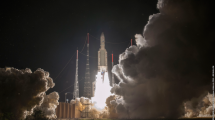Abstract
NASA’s New Horizons (NH) Pluto–Kuiper Belt (PKB) mission was selected for development on 29 November 2001 following a competitive selection resulting from a NASA mission Announcement of Opportunity. New Horizons is the first mission to the Pluto system and the Kuiper belt, and will complete the reconnaissance of the classical planets. New Horizons was launched on 19 January 2006 on a Jupiter Gravity Assist (JGA) trajectory toward the Pluto system, for a 14 July 2015 closest approach to Pluto; Jupiter closest approach occurred on 28 February 2007. The ∼400 kg spacecraft carries seven scientific instruments, including imagers, spectrometers, radio science, a plasma and particles suite, and a dust counter built by university students. NH will study the Pluto system over an 8-month period beginning in early 2015. Following its exploration of the Pluto system, NH will go on to reconnoiter one or two 30–50 kilometer diameter Kuiper Belt Objects (KBOs) if the spacecraft is in good health and NASA approves an extended mission. New Horizons has already demonstrated the ability of Principal Investigator (PI) led missions to use nuclear power sources and to be launched to the outer solar system. As well, the mission has demonstrated the ability of non-traditional entities, like the Johns Hopkins Applied Physics Laboratory (JHU/APL) and the Southwest Research Institute (SwRI) to explore the outer solar system, giving NASA new programmatic flexibility and enhancing the competitive options when selecting outer planet missions. If successful, NH will represent a watershed development in the scientific exploration of a new class of bodies in the solar system—dwarf planets, of worlds with exotic volatiles on their surfaces, of rapidly (possibly hydrodynamically) escaping atmospheres, and of giant impact derived satellite systems. It will also provide other valuable contributions to planetary science, including: the first dust density measurements beyond 18 AU, cratering records that shed light on both the ancient and present-day KBO impactor population down to tens of meters, and a key comparator to the puzzlingly active, former dwarf planet (now satellite of Neptune) called Triton which is in the same size class as the small planets Eris and Pluto.
Similar content being viewed by others
References
M.J. Belton et al., New frontiers in the solar system. An integrated exploration strategy. National Research Council, 2002, 145 pp.
Cheng et al., Space Sci. Rev. (2007, this issue). doi:10.1007/s11214-007-9271-6
R. Farquhar, A. Stern, Pushing back the frontier: A mission to the Pluto–Charon system. Planet. Rep. 10(4), 18–23 (1990)
Fountain et al., Space Sci. Rev. (2007, this issue)
Guo et al., Space Sci. Rev. (2007, this issue). doi:10.1007/s11214-007-9242-y
Horanyi et al., Space Sci. Rev. (2007, this issue)
J.I. Lunine et al., Report of the Pluto–Kuiper Express Science Definition Team, NASA, 1996
McComas et al., Space Sci. Rev. (2007, this issue). doi:10.1007/s11214-007-9205-3
McNutt et al., Space Sci. Rev. (2007, this issue)
NASA, Pluto Kuiper belt mission announcement of opportunity. Announcement of Opportunity 01-OSS-01, 2001
C.B. Olkin, D. Reuter, A. Lunsford, R.P. Binzel, S.A. Stern, The New Horizons distant flyby of asteroid 2002 JF56. American Astronomical Society, Division of Planetary Science meeting 38, 2006, abstract 9.22
Reuter et al., Space Sci. Rev. (2007, this issue)
S.A. Stern, The Pluto reconnaissance flyby mission. EOS 74, 73–75 (1993)
S.A. Stern, Journey to the farthest planet. Sci. Am. 286, 56–59 (2002)
S.A. Stern, A. Cheng, NASA plans Pluto–Kuiper belt mission. EOS 83, 101–106 (2002)
S.A. Stern, J. Mitton, Pluto and Charon: Ice Worlds on the Ragged Edge of the Solar System (Wiley-VCH, 2005), 244 pp.
Stern et al., Space Sci. Rev. (2007, this issue)
R.J. Terrile, S.A. Stern, R.L. Staehle, S.C. Brewster, J.B. Carraway, P.K. Henry, H. Price, S.S. Weinstein, Spacecraft missions to the Pluto and Charon system, in Pluto and Charon, ed. by S.A. Stern, D.J. Tholen (University of Arizona Press, Tucson, 1997), pp. 103–136
Tyler et al., Space Sci. Rev. (2007, this issue)
H.A. Weaver, S.A. Stern, M. Mutchler, A.J. Steffl, M.W. Buie, W.J. Merline, J.R. Spencer, E.F. Young, L.A. Young, The discovery of two new satellites of Pluto. Nature 439, 943–945 (2006)
Weaver et al., Space Sci. Rev. (2007, this issue)
Young et al., Space Sci. Rev. (2007, this issue)
Author information
Authors and Affiliations
Corresponding author
Rights and permissions
About this article
Cite this article
Stern, S.A. The New Horizons Pluto Kuiper Belt Mission: An Overview with Historical Context. Space Sci Rev 140, 3–21 (2008). https://doi.org/10.1007/s11214-007-9295-y
Received:
Accepted:
Published:
Issue Date:
DOI: https://doi.org/10.1007/s11214-007-9295-y




